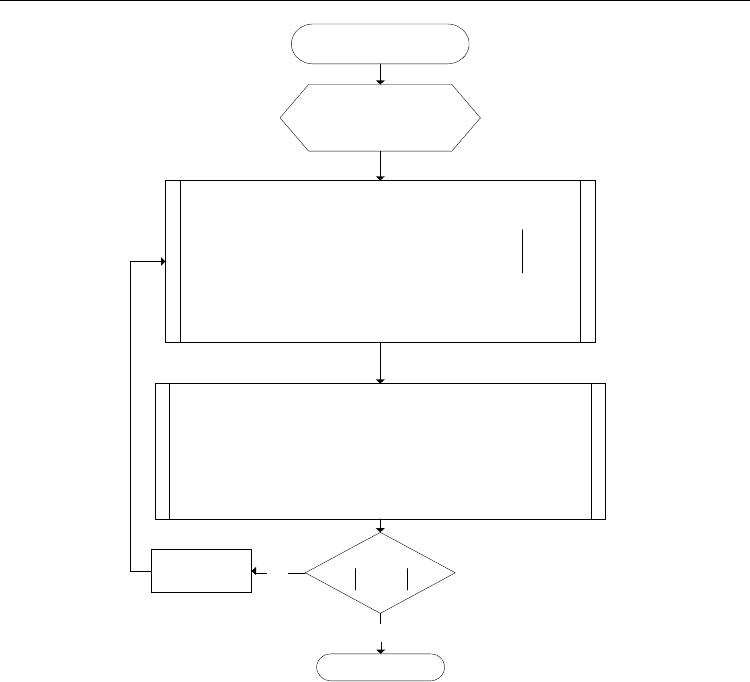Mellouk A., Chebira A. (eds.) Machine Learning
Подождите немного. Документ загружается.


Heuristic Dynamic Programming Nonlinear Optimal Controller
363
interleaved, each NN being updated at each time step. Tuning was performed online. A
Lyapunov approach was used to show that the method yields uniform ultimate bounded
stability and that the weight estimation errors are bounded, though convergence to the exact
optimal value and control was not shown. The input coupling function must be positive
definite.
In this chapter, we provide a full, rigorous proof of convergence of the online value-iteration
based HDP algorithm, to solve the DT HJB equation of the optimal control problem for
general nonlinear discrete-time systems. It is assumed that at each iteration, the value
update and policy update equations can be exactly solved. Note that this is true in the
specific case of the LQR, where the action is linear and the value quadratic in the states. For
implementation, two NN are used- the critic NN to approximate the value and the action
NN to approximate the control. Full knowledge of the system dynamics is not needed to
implement the HDP algorithm; in fact, the internal dynamics information is not needed. As
a value iteration based algorithm, of course, an initial stabilizing policy is not needed for
HDP.
The point is stressed that these results also hold for the special LQR case of linear systems
x
Ax Bu=+
and quadratic utility. In the general folklore of HDP for the LQR case, only a
single NN is used, namely a critic NN, and the action is updated using a standard matrix
equation derived from the stationarity condition (Lewis & Syrmos1995). In the DT case, this
equation requires the use of both the plant matrix A, e.g. the internal dynamics, and the
control input coupling matrix
B
. However, by using a second action NN, the knowledge of
the
A
matrix is not needed. This important issue is clarified herein.
Section two of the chapter starts by introducing the nonlinear discrete-time optimal control
problem. Section three demonstrates how to setup the HDP algorithm to solve for the
nonlinear discrete-time optimal control problem. In Section four, we prove the convergence
of HDP value iterations to the solution of the DT HJB equation. In Section five, we introduce
two neural network parametric structures to approximate the optimal value function and
policy. As is known, this provides a procedure for implementing the HDP algorithm. We
also discuss in that section how we implement the algorithm without having to know the
plant internal dynamics. Finally, Section six presents two examples that show the practical
effectiveness of the ADP technique. The first example in fact is a LQR example which uses
HDP with two NNs to solve the Riccati equation online without knowing the A matrix. The
second example considers a nonlinear system and the results are compared to solutions
based on State Dependent Riccati Equations (SDRE).
2. The discrete-time HJB equation
Consider an affine in input nonlinear dynamical-system of the form
1
() ()()
kkkk
x
fx gxux
+
=
+ . (1)
where
n
x
∈ \ , ()
n
fx
∈
\ , ()
nm
gx
×
∈ \ and the input
m
u ∈ \ . Suppose the system is drift-free
and, without loss of generality, that 0
x
=
is an equilibrium state, e.g. (0) 0f = , (0) 0g = .
Assume that the system (1) is stabilizable on a prescribed compact set
n
Ω
∈ \ .
Definition 1. Stabilizable system: A nonlinear dynamical system is defined to be stabilizable
on a compact set
n
Ω
∈ \ if there exists a control input
m
u ∈ \ such that, for all initial
conditions
0
x ∈Ω the state 0
k
x → as k →∞.

Machine Learning
364
It is desired to find the control action
()
k
ux which minimizes the infinite-horizon cost
function given as
() () () ()
T
knnn
nk
Vx Qx u x Rux
∞
=
=+
∑
(2)
for all x
k
, where () 0Qx > and 0
mm
R
×
>∈\ . The class of controllers needs to be stable and
also guarantee that (2) is finite, i.e. the control must be admissible (Abu-Khalaf & Lewis,
2005).
Definition 2. Admissible Control: A control
()
k
ux is defined to be admissible with respect
to (2) on
Ω if ()
k
ux is continuous on a compact set
n
Ω
∈ \ , (0) 0u
=
, u stabilizes (1) on Ω ,
and
00
, ( )
x
Vx∀∈Ω is finite.
Equation (2) can be written as
1
1
()
()
TT TT
kkkkk nnnn
nk
TT
kk kk k
Vx xQx uRu xQx uRu
xQx uRu Vx
∞
=+
+
=++ +
=++
∑
(3)
where we require the boundary condition
(0)0Vx
=
= so that ()
k
Vx serves as a Lyapunov
function. From Bellman’s optimality principle (Lewis & Syrmos, 1995), it is known that for
the infinite-horizon optimization case, the value function
()
k
Vx
∗
is time-invariant and
satisfies the discrete-time Hamilton-Jacobi-Bellman (HJB) equation
1
()min( ( ))
k
TT
kkkkkk
u
Vx xQx uRu Vx
∗∗
+
=++ (4)
Note that the discrete-time HJB equation develops backward-in time.
The optimal control u
∗
satisfies the first order necessary condition, given by the gradient of
the right hand side of (4) with respect to
u as
11
1
()()
0
T
TT
kk k k k k
kkk
xQx u Ru x V x
uux
∗
++
+
∂+ ∂∂
+
=
∂∂∂
(5)
and therefore
1
1
1
1()
() ()
2
T
k
kk
k
Vx
ux Rgx
x
∗
∗−
+
+
∂
=
∂
(6)
Substituting (6) in (4), one may write the discrete-time HJB as
1
11
1
11
1() ()
() () () ( )
4
T
TT
kk
kkk k k k
kk
Vx Vx
Vx xQx gxRgx Vx
xx
∗∗
∗−∗
++
+
++
∂∂
=+ +
∂∂
(7)
where
()
k
Vx
∗
is the value function corresponding to the optimal control policy ()
k
ux
∗
.
This equation reduces to the Riccati equation in the linear quadratic regulator (LQR) case,
which can be efficiently solved. In the general nonlinear case, the HJB cannot be solved
exactly.
In the next sections we apply the HDP algorithm to solve for the value function
V
∗
of the
HJB equation (7) and present a convergence proof.

Heuristic Dynamic Programming Nonlinear Optimal Controller
365
3. The HDP algorithm
The HDP value iteration algorithm (Werbos, 1990) is a method to solve the DT HJB online.
In this section, a proof of convergence of the HDP algorithm in the general nonlinear
discrete-time setting is presented.
3.1 The HDP algorithm
In the HDP algorithm, one starts with an initial value, e.g.
0
() 0Vx
=
and then solves for
0
u
as follows
01
()argmin( ( ))
TT
ok k k k
u
ux xQx uRuVx
+
=++ (8)
Once the policy
0
u is determined, iteration on the value is performed by computing
10000
0001
() () () (() ()())
() () ( )
TT
kkk k k k k k
TT
kk k k k
Vx xQx u x Rux Vfx gxux
xQx u x Ru x V x
+
=+ + +
=+ +
(9)
The HDP value iteration scheme therefore is a form of incremental optimization that requires
iterating between a sequence of action policies ()
i
ux determined by the greedy update
1
1
1
1
()argmin( ( ))
argmin( (() ()))
1()
()
2
TT
ik k k ik
u
TT
kk i k k
u
T
ik
k
k
ux xQx uRuVx
x
Qx u Ru V f x g x u
Vx
Rgx
x
+
−
+
+
=++
=+++
∂
=
∂
(10)
and a sequence () 0
i
Vx≥ where
11
()min( ( ))
() () (() ()())
TT
ik kk ik
u
TT
kk ik ik i k kik
Vx xQxuRuVx
xQx u x Ru x V f x gx u x
++
=++
=+ + +
(11)
with initial condition
0
()0
k
Vx
=
.
Note that, as a value-iteration algorithm, HDP does not require an initial stabilizing gain.
This is important as stabilizing gains are difficult to find for general nonlinear systems.
Note that
i is the value iterations index, while k is the time index. The HDP algorithm
results in an incremental optimization that is implemented forward in time and online.
Note that unlike the case for policy iterations in (Hewer, 1971), the sequence
()
ik
Vx is not a
sequence of cost functions and are therefore not Lyapunov functions for the corresponding
policies
()
ik
ux which are in turn not necessarily stabilizing. In Section four it is shown that
()
ik
Vx and ()
ik
ux converges to the value function of the optimal control problem and to
the corresponding optimal control policy respectively.
3.2 The special case of linear systems
Note that for the special case of linear systems, it can be shown that the HDP algorithm is
one way to solve the Discrete-Time Algebraic Riccati Equation (DARE) (Landelius, 1997)).
Particularly, for the discrete-time linear system

Machine Learning
366
1kkk
x
Ax Bu
+
=
+ (12)
the DT HJB equation (7) becomes the DARE
1
()
TTTT
P A PA Q A PB R B PB B PA
−
=+− +
(13)
with
()
T
kkk
Vx xPx
∗
= .
In the linear case, the policy update (10) is
1
() ( )
TT
ik i i k
ux R BPB BPAx
−
=− + (14)
Substituting this into (11), one sees that the HDP algorithm (10), (11) is equivalent to
1
1
0
()
0
TTTT
ii i i i
P A PA Q A PB R B PB B PA
P
−
+
=+− +
=
(15)
It should be noted that the HDP algorithm (15) solves the DARE forward in time, whereas
the dynamic programming recursion appearing in finite-horizon optimal control [21]
develops backward in time
1
1111
()
0
TTTT
kk k k k
N
P APAQAPBRBPB BPA
P
−
++++
=+− +
=
(16)
where
N
represents the terminal time. Both equations (15) and (16) will produce the same
sequence of
i
P and
k
P respectively. It has been shown in (Lewis & Syrmos, 1995) and
(Lancaster, 1995) that this sequence converges to the solution of the DARE after enough
iterations.
It is very important to point out the difference between equations (14) and (15) resulting
from HDP value iterations with
1
() ( )
i
TT
ik i i k
K
ux R BPB BPAx
−
=− +
(17)
11
00
()()
( , ): Initial stable control policy with corresponding Lyapunov function
TT
ii i i i i
ABK PABK P QKRK
Pu
++
++−=−−
(18)
resulting from policy iterations, those in(Hewer, 1971). Unlike
i
P
in (15), the sequence
i
P
in
(18) is a sequence of Lyapunov functions. Similarly the sequence of control policies in (17) is
stabilizing unlike the sequence in (14).
4. Convergence of the HDP algorithm
In this section, we present a proof of convergence for nonlinear HDP. That is, we prove
convergence of the iteration (10) and (11) to the optimal value, i.e.
i
VV
∗
→ and
i
uu
∗
→ as
i →∞. The linear quadratic case has been proven by (Lancaster, 1995) for the case of
known system dynamics.
Lemma 1. Let
i
μ
be any arbitrary sequence of control policies and
i
Λ
be defined by

Heuristic Dynamic Programming Nonlinear Optimal Controller
367
1
1
() () (() ()())
k
T
ik k iii k kik
x
xQx R fxgx x
μμ μ
+
+
Λ=+ +Λ +
. (19)
Let
i
u and
i
V be the sequences defined by (10) and (11). If
00
() ()0
kk
Vx x
=
Λ=, then
() ()
ik ik
Vx x≤Λ i
∀
.
Proof: Since
()
ik
ux minimizes the right hand side of equation (11) with respect to the control
u , and since
00
() ()0
kk
Vx x
=
Λ=, then by induction it follows that () ()
ik ik
Vx x
≤
Λ i∀ . ■
Lemma 2. Let the sequence
i
V be defined as in (11). If the system is controllable, then:
There exists an upper bound
()
k
Yx such that 0()()
ik k
Vx Yx
≤
≤ i
∀
.
If the optimal control problem (4) is solvable, there exists a least upper bound
() ()
kk
Vx Yx
∗
≤ where ()
k
Vx
∗
solves (7), and that :0 () () ()
ik k k
iVxVxYx
∗
∀≤ ≤ ≤ .
Proof: Let
()
k
x
η
be any stabilizing and admissible control policy, and Let
00
() ()0
kk
Vx Zx== where
i
Z
is updated as
11
1
() () () () ( )
() ()()
T
ik k k k ik
kkkk
Zx Qx xRx Zx
xfxgxx
ηη
η
++
+
=+ +
=+
. (20)
It follows that the difference
1111
12 22
23 33
10
() () ( ) ( )
() ()
() ()
.
.
.
() ()
ik ik ik ik
ik i k
ik ik
ki ki
Z x Zx Zx Z x
Zx Zx
Zx Zx
Zx Zx
++−+
−+ − +
−+ −+
++
−= −
=−
=−
=−
(21)
Since
0
()0
k
Zx = , it then follows that
11
1111
111112
11112 1
() ( ) ()
()( ) ()
()()() ()
( ) ( ) ( ) ....... ( )
ik ki ik
ki ki i k
ki ki ki i k
ki ki ki k
Zx Zx Zx
Zx Zx Z x
Zx Zx Zx Z x
Z
xZx Zx Zx
++
++−−
++−+−−
++−+−
=+
=+ +
=+ + +
=+ + ++
(22)
and equation (22) can be written as
11
0
0
0
() ( )
(( ) ( ) ( ))
(( ) ( ) ( ))
i
ik kn
n
i
T
kn kn kn
n
T
kn kn kn
n
Zx Zx
Qx x R x
Qx x R x
ηη
ηη
++
=
+++
=
∞
+++
=
=
=+
≤+
∑
∑
∑
(23)
Since ()
k
x
η
is an admissible stabilizing controller, 0
kn
x
+
→ as n →∞ and
11
0
:() ()()
ik ki k
i
iZx Zx Yx
∞
++
=
∀≤ =
∑

Machine Learning
368
Using Lemma 1 with
() ()
ik k
x
x
μ
η
=
and () ()
ik ik
x
Zx
Λ
= , it follows that
:() ()()
ik ik k
iVx Zx Yx∀≤≤
which proves part a). Moreover if
() ()
kk
x
ux
η
∗
= , then
00
()
()
( ( ) ( ) ( )) ( ( ) ( ) ( ))
k
k
TT
kn kn kn kn kn kn
nn
Yx
Vx
Qx u x Ru x Qx x R x
ηη
∗
∞∞
∗∗
+++ +++
==
+≤+
∑∑
and hence
() ()
kk
Vx Yx
∗
≤ which proves part b) and shows that :0 () () ()
ik k k
iVxVxYx
∗
∀≤ ≤ ≤
for any
()
k
Yx determined by an admissible stabilizing policy ()
k
x
η
. ■
Theorem 1. Consider the sequence
i
V
and
i
u
defined by (11) and (10) respectively. If
0
()0
k
Vx = , then it follows that
i
V is a non-decreasing sequence
1
:() ()
ik ik
iV x V x
+
∀≥
and as
i →∞
i
VV
∗
→ ,
i
uu
∗
→
that is the sequence
i
V converges to the solution of the DT HJB (7).
Proof: From Lemma 1, let
i
μ
be any arbitrary sequence of control policies and
i
Λ
be defined by
1
1
() () (() ()())
k
T
ik k iii k kik
x
xQx R fxgx x
μμ μ
+
+
Λ=+ +Λ +
If
00
() ()0
kk
Vx x=Λ = , it follows that () ()
ik ik
Vx x
≤
Λ i
∀
. Now assume that
1
() ()
ik i k
x
ux
μ
+
=
such that
1
11 1
() () (() ()())
() (() () ())
T
ik k i ii k kik
T
ki i i k kik
xQx R fxgx x
Qx u Ru f x gx u x
μμ μ
+
++ +
Λ=+ +Λ +
=+ +Λ +
(24)
and consider
1
() () (() ()())
T
ik k iii k kik
Vx Qx uRuVfx gxux
+
=++ + (25)
It will next be proven by induction that if
00
() ()0
kk
Vx x
=
Λ=, then
1
() ()
ik i k
x
Vx
+
Λ≤ .
Induction is initialized by letting
00
() ()0
kk
Vx x
=
Λ= and hence
10
10
() () ()
0
() ()
kkk
kk
Vx x Qx
Vx x
−Λ =
≥
≥Λ
Now assume that
1
() ()
ik i k
Vx x
−
≥Λ , then subtracting (24) from (25) it follows that
1111
() () ( ) ( )0
ik ik ik ik
Vx x Vx x
++−+
−
Λ= −Λ ≥

Heuristic Dynamic Programming Nonlinear Optimal Controller
369
and this completes the proof that
1
() ()
ik i k
x
Vx
+
Λ
≤ .
From
1
() ()
ik i k
x
Vx
+
Λ≤
and
() ()
ik ik
Vx x≤Λ
, it then follows that
1
:() ()
ik i k
iV x V x
+
∀
≤ .
From part a) in Lemma 2 and the fact that
i
V
is a non-decreasing sequence, it follows that
i
VV
∞
→
as i →∞. From part b) of Lemma 2, it also follows that () ()
kk
Vx Vx
∗
∞
≤ .
It now remains to show that in fact
V
∞
is V
∗
. To see this, note that from (11) it follows that
() () () (() ()())
TT
kkk k k k k k
Vx xQx uxRux Vfx gxux
∞∞∞∞∞
=+ + +
and hence
(() ()()) () () ()
TT
kkk kkkk k
Vfx gxux Vx xQx uxRux
∞∞∞ ∞∞
+−=−−
and therefore ()
k
Vx
∞
is a Lyapunov function for a stabilizing and admissible policy
() ()
kk
ux x
η
∞
= . Using part b) of Lemma 2 it follows that () () ()
kk k
Vx Yx Vx
∗
∞
=≥ . This
implies that
() () ()
kkk
Vx Vx Vx
∗∗
∞
≤≤ and hence () ()
kk
Vx Vx
∗
∞
= , () ()
kk
ux ux
∗
∞
= . ■
5. Neural network approximation for Value and Action
We have just proven that the nonlinear HDP algorithm converges to the value function of
the DT HJB equation that appears in the nonlinear discrete-time optimal control.
It was assumed that the action and value update equations (10), (11) can be exactly solved at
each iteration. In fact, these equations are difficult to solve for general nonlinear systems.
Therefore, for implementation purposes, one needs to approximate
,
ii
uV at each iteration.
This allows approximate solution of (10), (11).
In this section, we review how to implement the HDP value iterations algorithm with two
parametric structures such as neural networks (Werbos, 1990) and (Lewis & Jaganathan,
1999). The important point is stressed that the use of two NN, a critic for value function
approximation and an action NN for the control, allows the implementation of HDP in the
LQR case without knowing the system internal dynamics matrix A. This point is not generally
appreciated in the folklore of ADP.
5.1 NN approximation for implementation of HDP algorithm for nonlinear systems
It is well known that neural networks can be used to approximate smooth functions on
prescribed compact sets (Hornik & Stinchcombe, 1990). Therefore, to solve (11) and (10),
()
i
Vxis approximated at each step by a critic NN
1
ˆ
() () ()
L
jT
ivijVi
j
Vx w x W x
φ
=
==
∑
φ
(26)
and ()
i
ux by an action NN
1
ˆ
() () ()
M
jT
iuijui
j
ux w x W x
σ
=
==
∑
σ
(27)

Machine Learning
370
where the activation functions are respectively
1
(), () ()
jj
xxC
φσ
∈
Ω . Since it is required
that
(0)0
i
Vx== and (0)0
i
ux
=
= , we select activation functions with (0) 0, (0) 0
jj
φ
σ
==.
Moreover, since it is known that
V
∗
is a Lyapunov function, and Lyapunov proofs are
convenient if the Lyapunov function is symmetric and positive definite, it is convenient to
also require that the activation functions for the critic NN be symmetric, i.e.
() ( )
jj
x
x
φ
φ
=−.
The neural network weights in the critic NN (26) are
j
vi
w .
L
is the number of hidden-layer
neurons. The vector
[]
12
() () () ()
T
L
xxx x
φφ φ
≡ "
φ
is the vector activation function and
12
T
L
V i vi vi vi
Wwww
⎡⎤
≡
⎣⎦
"
is the weight vector at iteration
i
. Similarly, the weights of the
neural network in (27) are
j
ui
w .
M
is the number of hidden-layer neurons.
[]
12
() () () ()
T
L
x
xx x
σσ σ
≡ "
σ
is the vector activation function, and
12
T
L
ui ui ui ui
Wwww
⎡
⎤
≡
⎣
⎦
"
is
the vector weight.
According to (11), the critic weights are tuned at each iteration of HDP to minimize the
residual error between
1
ˆ
()
ik
Vx
+
and the target function defined in equation (28) in a least-
squares sense for a set of states
k
x
sampled from a compact set
n
Ω⊂\ .
1 1
1
ˆ
ˆˆ
(, , , ) () () ( )
ˆˆ
() () ( )
TT
kk Viui k k i k ik ik
TT T
kk ik ik Vi k
dx x W W xQx u x Ru x V x
xQx u x Ru x W x
+ +
+
=+ +
=+ +
φ
(28)
The residual error (c.f. temporal difference error) becomes
(
)
11
() (, , , ) ()
T
Vi k k k Vi ui L
WxdxxWWex
++
−=
φ
. (29)
Note that the residual error in (29) is explicit, in fact linear, in the tuning parameters
1Vi
W
+
.
Therefore, to find the least-squares solution, the method of weighted residuals may be used
[11]. The weights
1Vi
W
+
are determined by projecting the residual error onto
1
()
LVi
de x dW
+
and setting the result to zero
x
∀
∈Ω using the inner product, i.e.
()
,() 0
L
L
Vi +1
de x
ex
dW
=
, (30)
where
f,g
T
f
gdx
Ω
=
∫
is a Lebesgue integral. One has
(
)
11
0()() (,,,)
TT
k k Vi k k Vi ui k
x
xW d x x WW dx
φφ
++
Ω
=−
∫
(31)
Therefore a unique solution for
1Vi
W
+
exists and is computed as
1
1
()() ()((), , )
TT
Vi k k k k Vi ui
WxxdxxdxWWdx
φφ φ φ
−
+
ΩΩ
⎛⎞
=
⎜⎟
⎝⎠
∫∫
(32)
To use this solution, it is required that the outer product integral be positive definite. This is
known as a persistence of excitation condition in system theory. The next assumption is
standard in selecting the NN activation functions as a basis set.

Heuristic Dynamic Programming Nonlinear Optimal Controller
371
Assumption 1. The selected activation functions
{
}
()
L
j
x
φ
are linearly independent on the
compact set
n
Ω⊂\ .
Assumption 1 guarantees that excitation condition is satisfied and hence ()()
T
kk
x
xdx
φφ
Ω
∫
is
of full rank and invertible and a unique solution for (32) exists.
The action NN weights are tuned to solve (10) at each iteration. The use of
ˆ
(, )
ikui
uxW from
(27) allows the rewriting of equation (10) as
(
)
1
ˆ
ˆˆ
argmin ( , ) ( , ) ( )
TT i
ui k k i k ik ik
w
WxQxuxwRuxwVx
+
Ω
=+ + (33)
where
1
ˆ
() ()(,)
i
kkkik
x
fx gxuxw
+
=+ and the notation means minimization for a set of points
k
x
selected from the compact set
n
Ω
∈ \ .
Note that the control weights
ui
W appear in (33) in an implicit fashion, i.e. it is difficult to
solve explicitly for the weights since the current control weights determine
1k
x
+
. Therefore,
one can use an LMS algorithm on a training set constructed from
Ω
. The weight update is
therefore
1
1
1
1
1
ˆ
ˆˆ
((,)(,)()
()
ˆ
()2 (, ) ()
ui
m
TT
k k i k ui i k ui i k
mm
ui ui
mm
ui
W
T
T
k
ui ui k i k ui k Vi
mm m
k
xQx u xW RuxW Vx
WW
W
x
WW xRuxWgx W
x
α
φ
ασ
+
+
+
+
+
∂+ +
=−
∂
⎛⎞
∂
=− +
⎜⎟
∂
⎝⎠
(34)
where
α
is a positive step size and m is the iteration number for the LMS algorithm. By a
stochastic approximation type argument, the weights
ui ui
m
WW⇒ as m ⇒∞, and satisfy
(33). Note that one can use alternative tuning methods such as Newton’s method and
Levenberg-Marquardt in order to solve (33).
In Figure 1, the flow chart of the HDP iteration is shown. Note that because of the neural
network used to approximate the control policy the internal dynamics, i.e.
()
k
f
x is not
needed. That is, the internal dynamics can be unknown.
Remark. Neither ()
f
x nor ()
g
x is needed to update the critic neural network weights
using (32). Only the input coupling term
()
g
x is needed to update the action neural
network weights using (34). Therefore the proposed algorithm works for system with
partially unknown dynamics- no knowledge of the internal feedback structure
()
f
x is
needed.
5.2 HDP for Linear Systems Without Knowledge of Internal Dynamics
The general practice in the HDP folklore for linear quadratic systems is to use a critic NN to
approximate the value, and update the critic weights using a method such as the batch
update (32), or a recursive update method such as LMS. In fact, the critic weights are
nothing but the elements of the Riccati matrix and the activation functions are quadratic
polynomials in terms of the states. Then, the policy is updated using

Machine Learning
372
Updating the value function
Start of the HDP
Initialization
Solving the minimizing problem
Finish
0
0V
=
1
ˆˆ
ii
VV
ε
+
<
−
Yes
No
1
+
→ ii
ˆˆ
(,) (,)
argmin
ˆ
ˆ
(( ) ( )( ,))
TT
kk k k
ui
ik kk
xQx u x Rux
W
Vfx gxux
α
αα
α
Ω
⎛⎞
+
+
=
⎜⎟
⎜⎟
+
⎝⎠
1
11
ˆ
()() () ((), )
T
Vi k k k i k Vi
WxxdxxVxWdx
φφ φ φ
−
++
ΩΩ
⎛⎞
=
⎜⎟
⎝⎠
∫∫
ˆ
(, ) ()
T
i k Vi Vi k
VxW W x
φ
=
ˆ
(, ) ()
T
i k ui ui k
uxW W x
σ
=
Fig. 1. Flow chart shows the proposed algorithm
1
() ( )
TT
ik i i k
ux R BPB BPAx
−
=− + (35)
Note that this equation requires the full knowledge of both the internal dynamics matrix
A
and the control weighting matrix
B
. However, we have just seen (see remark above) that
the knowledge of the
A
matrix can be avoided by using, instead of the action update(35), a
second NN for the action
ˆ
() ()
T
iui
ux W x=
σ
In fact the action NN approximates the effects of
A
and
B
given in (35), and so effectively
learns the
A
matrix.
That is, using two NN even in the LQR case avoids the need to know the internal dynamics
A. In fact, in the next section we give a LQR example, and only the input coupling matrix B
is needed for the HDP algorithm. Nevertheless, the HDP converges to the correct LQR
Riccati solution matrix P.
